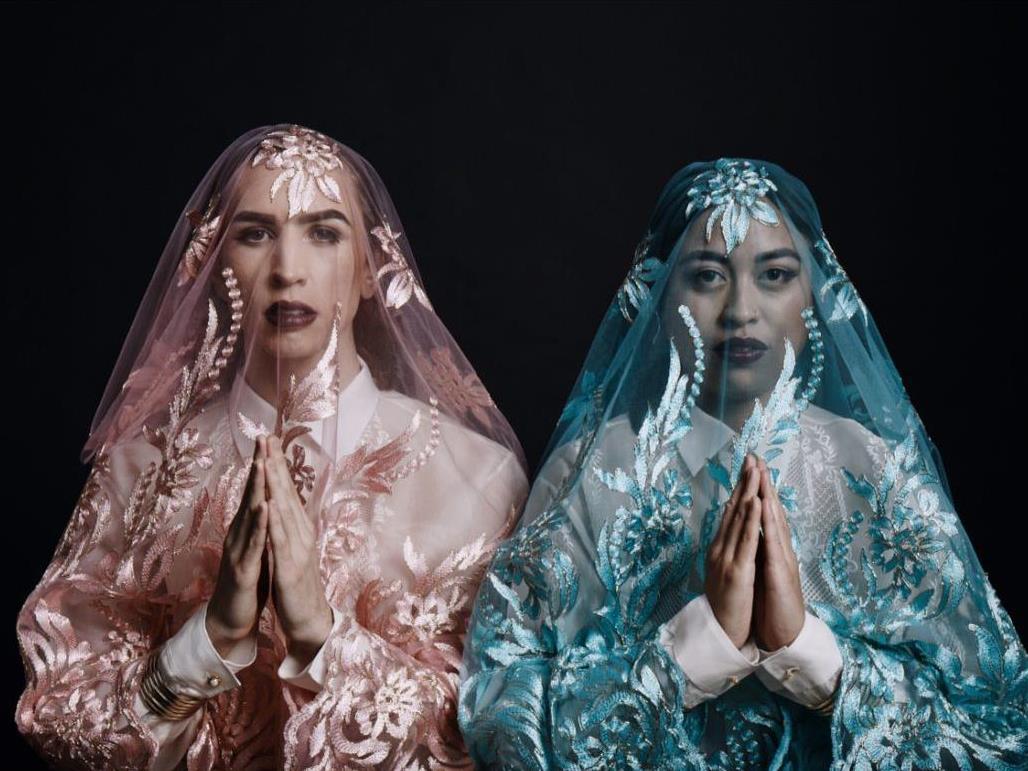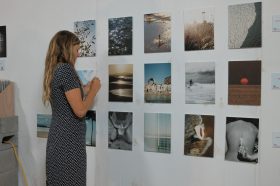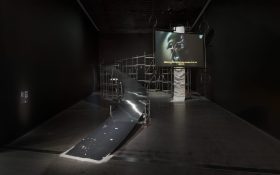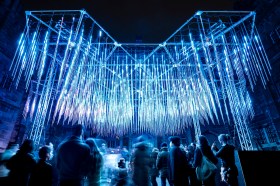Blacktown has the largest Filipino community in Australia, and a suite of exhibitions is finally acknowledging that cultural vibrancy. Bhenji Ra and Caroline Garcia by Joshua Morris, 2016; courtesy the artists
In April this year I wrote a tough opinion piece that argued the National Gallery of Australia (NGA) was ‘late to the party’ for its representation of Filipino artist Rodel Tapaya as the ‘hot new thing’.
At the time, Jaklyn Babington, NGA Senior Curator of Contemporary Art Practice, told ArtsHub the decision to focus on Tapaya was made because, ‘the Philippines was identified as a progressive and exciting scene. It was the Indonesian art scene a few years ago and now The Philippines is the hot place to be.’
Read: NGA not so cutting edge with Filipino art
While taking a serious look at what is shaping our zeitgeist is laudable, the choice of doing it with Tapaya’s work was hardly as ground breaking as it was presented. If one was to apply the same hardcore line to the Bayanihan Philippine Art Project – currently showing across five Sydney venues – it would need to be argued that the Project is also predictable and formulaic for the very same reasons.
While my earlier piece was described as suffering from a good dose of ‘The Phenomenon of Colonial Firsts’ – an attitude that suggests institutions need to validate their programs by being the first to ‘discover’ an artistic phenomenon – the tension here is between the idea of “first” and “overdue”.
This is not “new” art coming out of the region; it is celebrated, endorsed and incredibly good Filipino art heading to our shores – but as with Tapaya, it is long overdue, not new, and so the “hype” is a little off kilter.
Attempting a bigger picture
The Bayanihan Philippine Art Project is the most comprehensive look at contemporary Filipino art ever presented in Australia. Over a four-month period (July-October) a series of exhibitions, performances, creative writing and community programs are being offered across five Sydney galleries – the Art Gallery of New South Wales (AGNSW), Blacktown Arts Centre, Mosman Art Gallery, Peacock Gallery (Auburn) and Campbelltown Arts Centre in association with Museums & Galleries of NSW.
The project commemorates the 70-year anniversary of the establishment of diplomatic relations between Australia and the Philippines.
The individual exhibitions are strong – as is Tapaya’s exhibition at the NGA (closes 20 August) – but in contrast to the NGA, the Bayanihan Project taps more into the ethos of that moment and what it might mean for the exchange of ideas and cultures.
Alfredo and Isabel Aquilizan’s exhibition and community-driven art workshops at the Mosman Art Gallery, titled Halò, are a good example. They migrated to Australia in 2006 and continue to maintain studios in both Brisbane and Los Banos, Laguna; and their art making is intricately link between observing community and engaging communities.

Installation view of the Aquilizans work at Mosman Art Gallery; Photo ArtsHub
As curator Katrina Cashman says, ‘the Aquilizans are living embodiment of concepts regarding the porosity of global culture and the issues surrounding acculturation that they have long explored in their art practice.
‘Narrative, their own personal migratory experience and the resultant dislocation and transience directly inform their work, while ironically the increasing international demand for their work has in part added to and prolonged this state of flux.’
Halò is also accompanied by an anthology of contemporary Philippine and Australian creative writing.
Similarly, David Griggs’ survey exhibition Between Nature and Sin, at the Campbelltown Art Centre (CAC) has been 12 years in the making as he journeyed between the back street of Manila and the Australian art world – this bump and jar of life playing out on the canvas.

Installation view David Griggs exhibition at Campbelltown Art Centre; Photo ArtsHub
Curator Megan Monte says his ‘borrowed popular imagery and street stories become Griggs’ visual vocabulary’ and will shift the way we experience painting. The exhibition tours to eight regional venues across NSW in 2018-1019.
Central to Griggs’ engagement in Manila has been his embeddedness with a local art community, even to the point of opening an art space, LOST, which invited Australian artists to visit and participate.
Blacktown Arts Centre (BAC) also turns to this transient thread of connecting Australia and the Philippines in its project Balik Bayan – literally translated as ‘a return to country’. It is a multi-art form project that sees the art centre transform into a gathering place of intersecting contemporary art forms: video, installation, painting, performance, film, community engagement, workshops and events. The final day of the exhibition is timed for All Souls Day (2 November), a significant date in the Filipino cultural calendar.
The other community player in this project is Peacock Gallery in Auburn. Their project, Balik Tanaw (Looking Back) is a response by four artists (Alwin Raemillo, Ernest Aaron, Alberto Estanislao, Jessa Melicor) to the concept of ‘home’ in Western Sydney and in the Philippines and the maintenance of Philippine Culture. The exhibition includes a new iteration of the Bayanihan Hopping Spirit House (Alwin Reamillo and Urban Theatre Projects) with a hands-on ‘hop’ on 2 September.

Supplied Peacock Gallery
How moving house led to moving art
The word Bayanihan (pronounced ‘buy-uh-nee-hun’) is a Filipino custom derived from a Filipino word “bayan”, which refers to the spirit of communal unity, work and cooperation to achieve a particular goal. The term derives from a rural tradition of moving house, where a community would literally pick up and relocate not only a family’s possessions, but their home.
This foundation of community and exchange has been key to the curatorial frame for the Bayanihan Project.
For a start, the people born in the Philippines comprise 9% of the population in the City of Blacktown – the area’s largest ethnic group – and there are over 160,000 Filipino Australians (2006 census). This number far outweighs Indonesian-born residents in Australia, and lags only slightly behind Chinese Australians, Indian Australians and Vietnamese Australians – and yet they are largely invisible culturally in Australian programming.
Art Patron and former Chair of VisAsia at AGNSW Dr John Yu AC told media: ‘Everyone’s ignored the Philippines.’
Yu said there has been a growing recognition of the art of the Southeast Asian region over the last few decades but little attention has been paid to the art of the Philippines. Yu was the impetus behind the Bayanihan Project, and approached Mosman Art Gallery with the idea to redress this imbalance.
In that collaborative, community spirit Yu, together with partner Dr George Soutter, gifted a significant collection of Philippine art, textiles and sculptural objects to the AGNSW in 2005, which have been pulled out in an attempt to provide historical context for this exhibition.
It was a win to fall back on this collection in the wake of conversations breaking down between the institution and the National Museum of the Philippines, which was to loan historically significant Philippine artworks for the Project. But with that historical hinge that would have provided context for the project turned on its head and took a contemporary view.
Titled Passion and procession: art of the Philippines, the exhibition includes works by Santiago Bose, Marina Cruz, Alfredo Esquillo Jr, Nona Garcia, Renato Habulan, Geraldine Javier, Mark Justiniani, Alwin Reamillo, Norberto Roldan and Rodel Tapaya – a top drawer (but somewhat safe) roll call of contemporary Filipino artists who are all award winners and have international reputations.
The gallery explains: ‘The works draw on folk mythology, family archives, nature and religious ceremony to reconsider established narratives of history and nation.’

Installation view AGNSW; Photo ArtsHub
Diverting slightly, Reamillo has connections with Australia (also showing at Blacktown for this Project) and Roldan has played a key arts administration role, often facilitating visiting artists and curators through his Green Papaya Art Projects space. They make sense in the context of this diplomatic/cultural anniversary, while the other artists tend to round out a scene of peers. What is lacking in their exhibition iis the sense of volume or breadth of that scene, which the AGNSW says is a 20-year snapshot.
Curiously, the AGNSW has used an image of Tapaya’s work to promote the exhibition, perhaps confusing what’s on with the NGA’s exhibition. And like Tapaya’s work, this exhibition is a stunning hang and a seriously good representation of these artists. It is just a very narrow, and predictable, picture.
To bounce back to the gallery’s own words: ‘When Dr Yu visited the Philippines as a paediatrician in the 1970s he was hooked on the country’s art.’
Four decades later we are finally looking at Filipino art in Australia, and the lag can be felt.
Overall The Bayanihan Philippine Art Project is a fantastic look at contemporary Philippine art and a great way to get a quick grasp on the kinds of conversations that percolate within this art scene. But like any survey it is far from comprehensive or placed in enough context. If one is to approach it as a series of individual exhibitions – as indeed it was curated – then each is weighty (especially the solo shows), integrated, accomplished and – most importantly of all – an enjoyable insight.
Venue details for The Bayanihan Philippine Art Project
Passion and procession: art of the Philippines
At the Art Gallery of New South Wales from 24 June – 12 November 2017.
Between Nature and Sin: David Griggs
Campbelltown Arts Centre from 5 August – 15 October 2017
Halò: Alfredo Juan Aquliazn and Isabel Gaudinez-Aquilizan
And JD Reforma
Mosman Art Gallery from 1 July – 10 September 2017
Blacktown Arts Centre from 7 September – 2 November 2017
Peacock Gallery, Auburn, from 8 July- 3 September 2017





